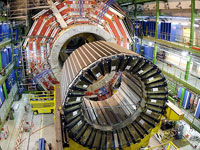Large Hadron Collider Conducts Its First Successful Test
Nuclear scientists successfully put back the Large Hadron Collider to work Monday with a successful first test of smashing proton beams at the speed of light.

The underground proton smasher run by physicists of the European Center for Nuclear Research outside Geneva aims to recreate the forces and particles that existed seconds after the Big Bang by accelerating and smashing together two beams of protons.
The test used energies of 450 billion electron volts to accelerate the protons at opposite direction. Succeeding tests will use 1.2 trillion electron volts per beam, surpassing that of the Tevatron at Fermilab in Illinois. The Tevatron had achieved energies of 900 billion electron volts, AHN reports.
"It was just a preliminary test," said James Gillies, spokesman for the European Organization for Nuclear Research. But the machine showed it could raise the energy of the proton beams whizzing around the massive machine by an initial 10 percent.
"It's good," Gillies said in an interview. "It's all going very well."
The new step in the startup phase indicated continued smooth operation of the Large Hadron Collider since its repairs following a spectacular collapse last year.
It followed a speedy startup beginning Friday night when the LHC injected the first beams, later getting them to run in both directions and even record the first proton collisions at high energy to test the detectors of what that will reveal about the insides of the subatomic particles and forces.
The first science test of the LHC will come in the first two months of 2010, when scientists plan to start deliberately crashing protons into each other to see what they can discover about the makeup of the universe and its tiniest particles.
The collisions — seen by massive detectors — were a side effect of collisions when the beams traveling in opposite directions crossed in the detectors, which recorded them at "experiments" in rooms the size of cathedrals about 100 meters (300 feet) underground around the collider, The Associated Press reports.
Experiments in a previous collider at the CERN research center near Geneva at the foot of the French Jura mountains staged particle collisions producing energy very close to that of the Big Bang.
The LHC operating at its full might should recreate conditions like those just one billionth of a second after the primeval explosion.
The scientists now plan to increase the beam intensity and accelerate the beams further so they can gather enough collision data by Christmas to help set up experiments, Reuters informs.
Subscribe to Pravda.Ru Telegram channel, Facebook, RSS!


